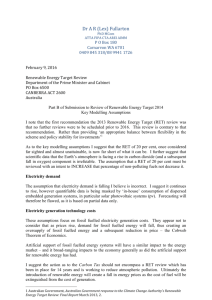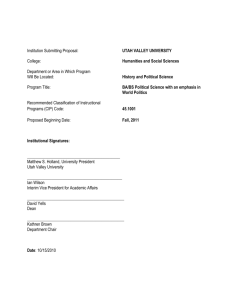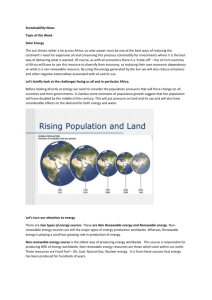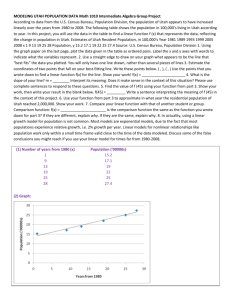Comments from iMatter Utah - Utah Public Service Commission
advertisement
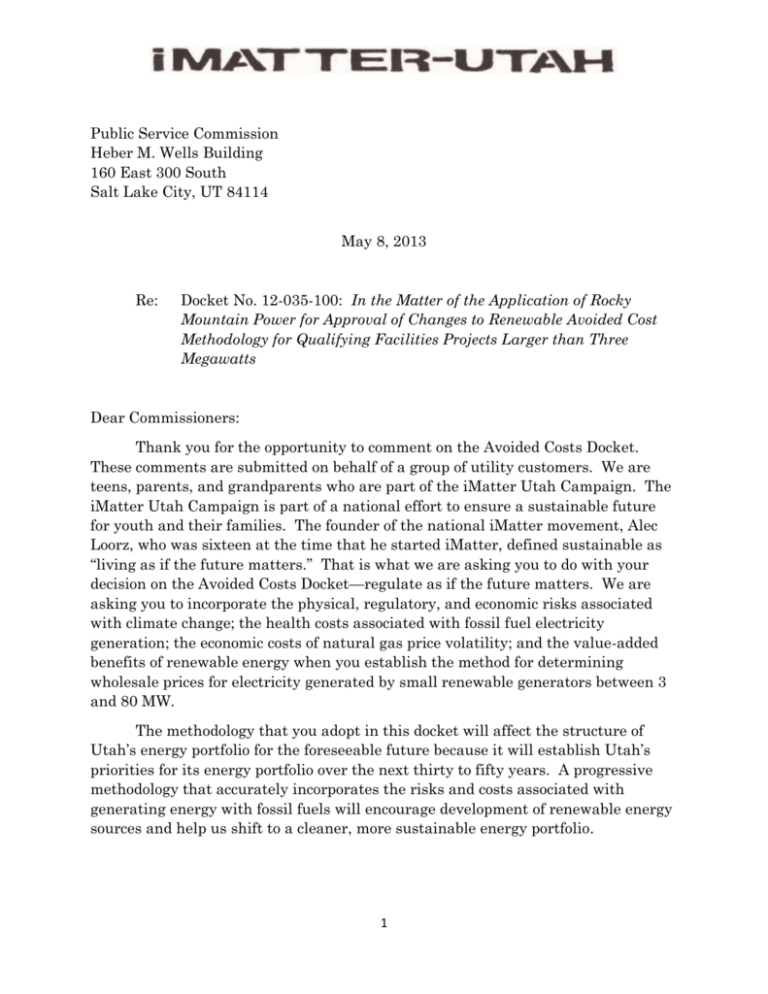
Public Service Commission Heber M. Wells Building 160 East 300 South Salt Lake City, UT 84114 May 8, 2013 Re: Docket No. 12-035-100: In the Matter of the Application of Rocky Mountain Power for Approval of Changes to Renewable Avoided Cost Methodology for Qualifying Facilities Projects Larger than Three Megawatts Dear Commissioners: Thank you for the opportunity to comment on the Avoided Costs Docket. These comments are submitted on behalf of a group of utility customers. We are teens, parents, and grandparents who are part of the iMatter Utah Campaign. The iMatter Utah Campaign is part of a national effort to ensure a sustainable future for youth and their families. The founder of the national iMatter movement, Alec Loorz, who was sixteen at the time that he started iMatter, defined sustainable as “living as if the future matters.” That is what we are asking you to do with your decision on the Avoided Costs Docket—regulate as if the future matters. We are asking you to incorporate the physical, regulatory, and economic risks associated with climate change; the health costs associated with fossil fuel electricity generation; the economic costs of natural gas price volatility; and the value-added benefits of renewable energy when you establish the method for determining wholesale prices for electricity generated by small renewable generators between 3 and 80 MW. The methodology that you adopt in this docket will affect the structure of Utah’s energy portfolio for the foreseeable future because it will establish Utah’s priorities for its energy portfolio over the next thirty to fifty years. A progressive methodology that accurately incorporates the risks and costs associated with generating energy with fossil fuels will encourage development of renewable energy sources and help us shift to a cleaner, more sustainable energy portfolio. 1 Your decision on the Avoided Costs Docket is being made at a time when “business as usual is not an option.”1 That statement sounds like hyperbole, but it is not. It is the conclusion reached by the venerable firm PricewaterhouseCooper in its latest report on carbon emissions scenarios.2 The report evaluates the worldwide rate of carbon emissions and concludes that in order keep the global average temperature increase to approximately 2° C (a target adopted by every country in the world) would require a six-fold improvement in the world’s current rate of carbon emission reductions. A chart produced on page 9 of the report is truly startling. It shows that if the world continues to reduce carbon emissions at only 1.6% per year, which is similar to the amount of carbon emissions reductions achieved by the U.S. last year, the implied CO2e3 concentrations in the atmosphere (exclusive of feedback effects) will be 1,200 ppm CO2e by 2050, with an associated 6° C of warming. This demonstrates that we cannot continue to rely on electricity generated by fossil fuels without incurring enormous risk of physical and environmental harm, and that the harm will be experienced by young people who are alive today. Those numbers are terrifying for the youth in our group. Some of our youth advocates just turned 18. In 2050 they will be 55. If we do not reduce our carbon emissions, we are leaving them no hope for their future. Just to be clear, a planet warmed by six-degrees may not be survivable. For example, the assessment report issued by the International Panel on Climate Change in 2007 projected that a temperature increase of 2° would result in the extinction of 20-30% of the known species on earth and severely compromise ecosystem services, like fresh water and food.4 The IPCC’s projection is a conservative estimate because it does not take into account feedback loops, land use change, or the risk of abrupt change. Even a fourdegree scenario may not be survivable according to a report issued by the World Bank in November 2012 that evaluated the risks associated with a 4° warming scenario.5 The Executive Summary concluded “There is no certainty that adaptation to a 4° C world is possible.” In other words, the complications associated with climate change are not problems for future generations. They are problems for PricewaterhouseCooper, LLC, Too Late for Two Degrees? Low Carbon Economy Index 2012, pg. 9 (November 2012). 2 Id. 3 CO2e refers to carbon emission equivalents. It takes into account the warming properties of twelve other gasses. 4 2007: Summary for Policymakers in Climate Change 2007: Impacts, Adaptation and Vulnerability. Contribution of Working Group II to the Fourth Assessment Report of the Intergovernmental Panel on Climate Change, M.L. Parry, O.F. Canziani,J.P. Palutikof, P.J. van der Linden and C.E. Hanson, Eds., Cambridge University Press, Cambridge, UK, 7-22 (Summary for Policy Makers, 11). 5 The World Bank, Turn Down the Heat: Why a 4° C Warmer World Must Be Avoided, xviii (Nov. 2012). 1 2 this generation. That is why we are asking the Public Service Commission to account for cost of health and physical risks associated with climate change when determining the pricing methodology for electricity generated by small renewable generators. The Public Service Commission should also include the risk that investments in fossil fuel electricity generation may be stranded if climate change regulations are adopted on a national or international scale. Despite (or because of) the stark projections in the report cited above, the iMatter Utah Campaign is just one of several advocacy campaigns whose members are working tirelessly to limit warming to the 2° C scenario. As the President of the World Bank, Dr. Jim Yong Kim summarized, in order to avoid warming that exceeds 4° C, we must engage in “effective risk management and ensuring all our work, all our thinking, is designed with the threat of a 4° C world in mind.”6 We agree with him, and hope that the regulatory structure of the United States will respond to this risk. There is some indication that our hope for courageous government action in the face of this threat is not unfounded. In his inaugural address, President Obama stated that he would take courageous action on climate change. “We will respond to climate change, knowing that failure to do so would betray our children and future generations.” Even if Congress fails to adopt comprehensive legislation, the executive branch has ample authority to begin making significant regulatory changes. According to some legal analysts, additional legislation is not necessary in order to respond to climate change because extensive carbon emission reductions can be accomplished through the Clean Air Act.7 The likelihood that stringent carbon emission regulations will be adopted in the foreseeable future, makes investing in fossil fuel electricity generation economically risky. iMatter Utah is not alone in anticipating that regulations could result in stranded fossil-fuel investments. On February 8, 2010, the Securities and Exchange Council issued guidance directing publicly traded companies to disclose the risk of regulation associated with climate change to investors.8 If the risk of Id. (Foreword). Kassie Siegel, Kevin Bundy, Vera Pardee, Strong Law, Timid Implementation. How the EPA Can Apply the Full Force of the Clean Air Act to Address Climate Change (April 2012) available at http://www2.law.ucla.edu/jelp/JELP/Publications/Entries/2012/4/16_Volume_30_Issue_1_files/Siegel. pdf. See also Petition to Establish National Pollution Limits for Greenhouse Gases Pursuant to the Clean Air Act (Dec. 2, 2009) available at http://www.openmarket.org/wpcontent/uploads/2009/12/cbd-350org-petition.pdf. 8 Securities and Exchange Commission, Release Nos. 33-9106, Commission Guidance Regarding Disclosure Related to Climate Change, 82 Fed. Reg. 34-61469 (“For some companies, the regulatory, legislative, and other developments noted above could have a significant effect on operating and financial decisions, including those involving capital expenditures to reduce emissions and, for 6 7 3 regulation is material enough for investors in the stock market to consider, it is material enough for this Commission to consider as it fulfills its mandate to regulate energy generation by Rocky Mountain Power Corp.. The economic risk caused by climate change regulation does not only affect regulated entities. As the SEC pointed out, “Companies that may not be directly affected by such developments [regulations] could nonetheless be indirectly affected by changing prices for goods or services provided by companies that are directly affected and that seek to reflect some or all of their changes in costs of goods in the prices they charge. For example, if a supplier’s costs increase, that could have a significant impact on its customers if those costs are passed through, resulting in higher prices for customers.”9 As consumers, we hope that the Public Service Commission will take into account the high likelihood that increased costs caused by climate regulation will be passed along, resulting in higher energy prices for consumers if our electricity is generated by fossil fuels. This risk of increased energy costs in the foreseeable future should be included in the methodology adopted by the Commission for determining wholesale prices for electricity generated by small renewable generators. Renewable energy development will allow Rocky Mountain Power to mitigate, and perhaps even avoid, the real and growing costs associated with climate regulation. Anticipating these avoided costs falls squarely within the Public Service Commission’s mandate to, “engage in long-range planning regarding public utility regulatory policy in order to facilitate the well-planned development and conservation of utility resources.”10 As consumers, we want to avoid the economic risk of higher energy prices caused by climate regulation. We want Utah to invest in renewable energy resources now, and we are willing to pay an increased price for the added value of building a stable-priced energy infrastructure that will be less costly in the long-term. That is why we are asking the Public Service Commission to include the economic risk associated with investing in or relying on fossil fuel energy generation when determining wholesale prices for electricity generated by small renewable generators. If the methodology adopted by the Public Service Commission appropriately values and compensates the ability of renewable energy to avoid long-term costs and risks associated with fossil fuel generated electricity, the decision made by this companies subject to ‘cap and trade’ laws, expenses related to purchasing allowances where reductions cannot be met..” 9 Id. 10 Utah Code Ann. § 54-1-10. 4 Commission will facilitate the well-planned development and conservation of utility resources in Utah. Thank you for the opportunity to comment on this important docket. The decisions and the responsibilities resting on the shoulders of the Public Service Commission are weighty and important. We appreciate your thoughtful consideration of our comments. An original and ten (10) copies of this filing will be provided via hand delivery. iMatter Utah will also provide electronic versions of this filing to psc@utah.gov. iMatter Utah also respectfully requests that all formal correspondence and requests for additional information regarding this filing be addressed to Jamie Pleune at the following addresses: By E-mail: jpleune@mohrmanandschofield.com (until June 1, 2013 then at jamie-pleune@rbmn.com) By Mail: 175 Main St. Suite 900 Sale Lake City, UT 84111 Sincerely, __/s/ Jamie Pleune______ Jamie Pleune on behalf of iMatter Utah www.imatterutah.org cc: Director of the Office of Consumer Services, Michele Beck (mbeck@utah.gov) Director of Division of Public Utilities, Chris Parker (chrisparker@utah.gov) 5



